For any man, woman or child, although their face may not be their fortune as the nursery rhyme goes, it can be considered one of the most important parts of the body and is cherished and pampered.
Inextricably linked with the face would be the pigmentation or colour of the skin (epidermis) which gives it not only the natural complexion but also the inherited texture.
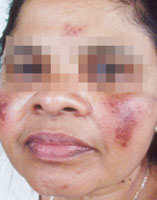 |
| Melasma |
"From the point of view of looks the most important is the face and the second most important are the hands," says popular Dermatologist Dr. Lakshman Ranasinghe, explaining that sometimes something goes awry with the pigmentation on the face leading to much concern, heart-ache and lowered self-esteem.
Facial pigmentation can manifest as normal pigmentation, hyper-pigmentation or hypo-pigmentation, MediScene understands.
Very simply put, hyper- or hypo-pigmentation means that faces affected by either condition would have patches in several areas, says Dr. Ranasinghe.
Dealing with the aspect of hyper-pigmentation or too much pigmentation on any part of the face and neck, he picks out melasma, where dark patches of discolouration are seen on the face.
Melasma manifests more in women who are in their "fertile 40s" (as it is traditionally called), than in men, with those having fairer complexions being more vulnerable. Commonly affecting women between the age of 30 and 40 years, it is also seen among those who are on the birth control pill, says Dr. Ranasinghe, adding that a link has been established between melasma and the sex hormones, particularly oestrogen.
Melasma can be quite disfiguring, MediScene learns. The first signs of melasma are tiny spots that appear on one or both summits of the cheeks which gradually become like a rain-cloud on each side. It can also take the shape of a disc on the centre of each cheek.
This same pigmentation can also be seen in curvi-linear form above the lip, like a moustache, causing much embarrassment, says Dr. Ranasinghe adding that the site of melasma often takes the shape of a saddle – like pigmentation in or around the middle one-third of the nose – extending outward to join the patches on the cheek.
"Sometimes triangular patches of pigmentation appear outside the cheeks pointing toward the cheeks. This is more difficult to treat. Linear, dark brown pigmentation can also appear above the outer half of each eye-brow," he says.
 |
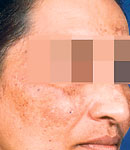 |
| Melasma: Before treatment (left) and after (right) |
Unfortunately, there is no permanent cure for melasma, with laser treatment clearing it in some patients and making it worse in others, says Dr. Ranasinghe.
"Attempts at treatment first started 50 years ago with the use of chemicals and peeling agents. As time went on it was discovered that hydroquinone, and later, azelaic and kojic acids did clear the patches in some patients, as long as they were used. However, more than half of the patients were not relieved of the patches and some cosmetic dermatologists used a higher strength of hydroquinone together with a sun-block to help them."
Melasma can be made worse by sun exposure, it is learnt. But when the strength of hydroquinone is increased, the skin becomes inflamed and to counter this, anti-inflammatory agents like topical steroids have been used. Freezing and peeling can also be applied but can be carried out only in small or limited areas.
Exasperated cosmetic dermatologists may prescribe masking creams to cover the disfiguring marks, most of which are washable and, therefore, a nuisance, says Dr. Ranasinghe, giving hope by adding that now masking creams finished off with a layer of fixing powder which can be retained for up to a week are available.
Causes and
treatment
Besides the usual birthmarks and moles which some consider to be "beauty-spots", there can be dark patches especially on the sides of the face going into the neck, from birth.
Did you know that the ancient Greeks believed that if someone had a birthmark, it meant that the gods had earmarked him or her for preferential treatment, asks Dr. Ranasinghe, adding that today, however, with the blossoming of cosmetics and cosmetic dermatology, people who feel that such birthmarks are ugly or too big often seek a remedy.
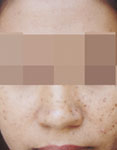 |
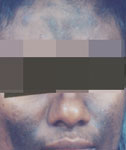 |
| Freckles |
Pigmentation of grooves of the face |
But be careful of laser treatment, he cautions, because getting the birthmark laser treated may not give a better result. "Utmost expertise is required when using lasers to cause more good than harm. Otherwise you could end up with an ugly scar," he warns.
During adolescence, a child in the age-group 12-14 years could also develop specks of pigmentation on the nose going onto the cheeks. These are freckles which are often inherited from a parent, says Dr. Ranasinghe, adding that these can be treated by cryo-therapy (freezing).
Post-inflammatory patches of pigmentation on the face and elsewhere can also result from scratching, wounds and dog-bite, MediScene learns. Chicken pox scars may also develop into small black spots on the entire face, limbs and body, which may take more than two years to clear up completely.
Physical agents too may cause pigmentation of the face, stresses Dr. Ranasinghe, pointing out that the commonest such natural agent is the sun, the rays of which in addition to causing burns, irritation and other reactions can also result in pigmentation.
Film actresses out on location and politicians canvassing from door-to-door in the sun are prone to solar pigmentation or photo-pigmentation. The sun can cause damage to fair skin not only among Caucasians but also in very fair-complexioned Sri Lankans, according to him. "Solar pigmentation is seen mostly on the forehead (more towards the scalp), while the area above the eye-brows usually retains the original colour. This applies also to the nose and sides of the face."
In schoolchildren, however, solar pigmentation is seen more as patchy de-pigmentation rather than pigmentation, says Dr. Ranasinghe, adding that this is common during the cricketing season and at sportsmeets. There is no need for alarm, he assures, adding that the de-pigmentation will gradually fade away. If the parents would rather not wait, for fear of the more dreaded vitiligo and leprosy, specialist consultation is advised.
Explaining the adverse effects of sunbathing, he emphasizes that it damages the skin rather badly. The skin of those who begin to sunbathe early in adult life ages faster, he says, citing the example of the face of a 30-year-old looking more like a 50-year-old, especially due to puckering around the eyes and the lips.
In Caucasians and very fair-skinned Asians, the sun can cause cancers, the most dreaded of which are the black patches called melanoma, says Dr. Ranasinghe. This is very rare in South Asians because the natural pigment (melanin) protects the exposed skin.
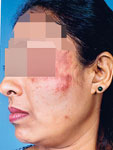 |
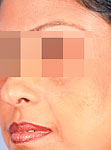 |
| Post laser
pigmentation |
After treatment |
To check whether the sun does affect your skin colour, he suggests a simple test - draw the front neckline of the blouse or shirt outward and if the skin is fairer under the garment than in the exposed centre of the chest, the sun has affected your complexion.
"The bottom line is that you must protect your face, chest and hands from the sun after 9 a.m. and before 4 p.m. While the application of sun-block creams and lotions helps only for short periods of about three hours, it is better to avoid the sun rather than use them several times a day," he says.
Meanwhile caustic chemicals, acids and alkalies sometimes used deliberately by children and young people to evoke sympathy and sometimes older or demented patients too can produce scarring and pigmentation. The last category is called factitial dermatitis or dermatitis artifacta, adds Dr. Ranasinghe.
|







